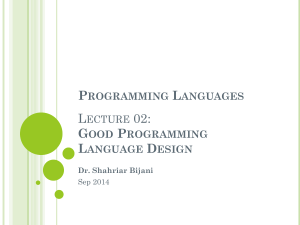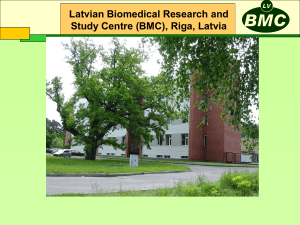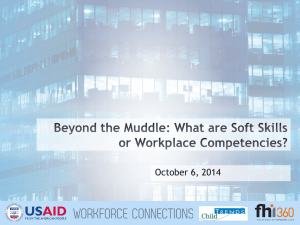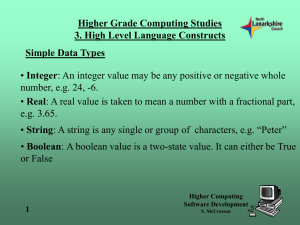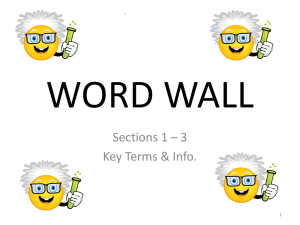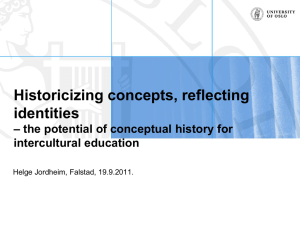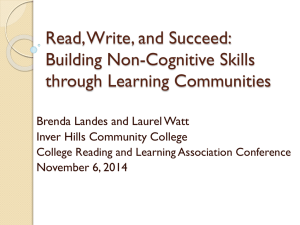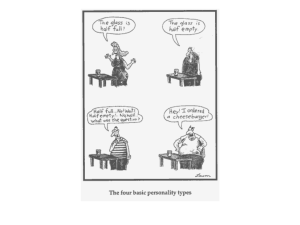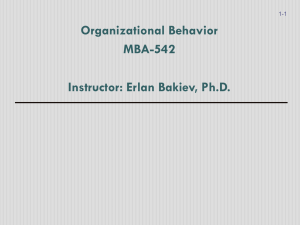Big 5
advertisement
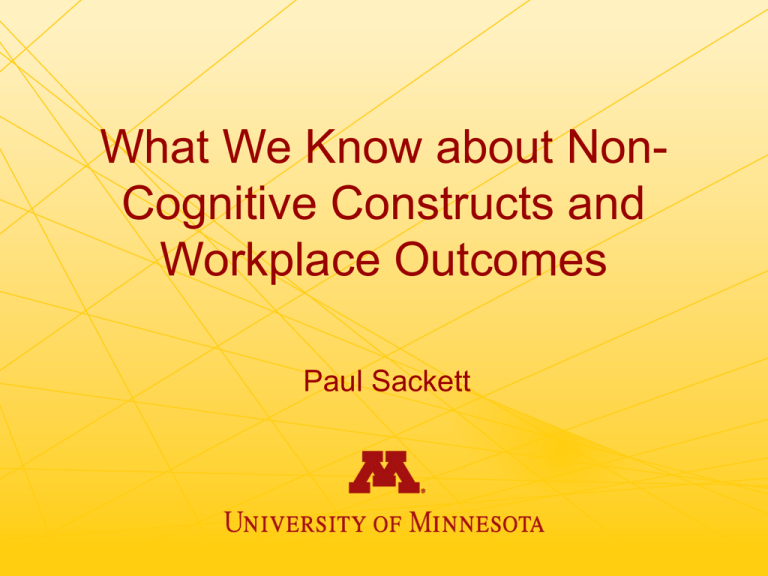
What We Know about NonCognitive Constructs and Workplace Outcomes Paul Sackett Question: what non-cognitive constructs are valued in the workplace? Sources of information: 1) The research literature on the use of noncognitive constructs to predict work behaviors 2) Literature on constructs employers seek in job applicants 3) Job-analytic data on constructs important for various occupations Approach 1: The literature on non-cognitive constructs predicting work outcomes • The predictor side of the equation – Confounding of constructs and methods is common • Many predictors are methods that can be used to measure various constructs (e.g., interviews, situational judgment tests) – Focus on constructs in the personality domain • • The “Big 5” as a broad general framework Conscientiousness, Agreeableness, Openness, Emotional Stability, Extraversion as the highest level aggregates The “Big 5” • Conscientiousness – • Agreeableness – • Calm, self-confident, resilient Extraversion – • Cooperative, flexible, tolerant, forgiving Emotional Stability – • Dependable, achievement-striving, hardworking, persevering, orderly Sociable, talkative, assertive, active Openness to experience – Curious, broad-minded, intelligent, cultured Approach 1: Non-cognitive constructs and work outcomes (continued) • The criterion side of the equation – Current frameworks focus on three components of overall job performance • Task performance • Organizational Citizenship Behavior (OCB) • Counterproductive Work Behavior (CWB) Approach 1: Non-cognitive constructs and work outcomes (continued) • • • • Strategy: examine the Big 5 as predictors of Task Performance, OCB, and CWB Focus on “landmark” studies and metaanalyses Analysis is “impressionistic”, looking for general patterns Analysis represents grand average across jobs Big 5 Predicting Organizational Citizenship Behavior (OCB) Mean Min Conscientiousness Agreeableness Emotional Stability Extraversion Openness 0.21 0.14 0.16 0.08 0.03 0.18 0.10 0.14 0.05 0.01 Max Mean Rank 0.30 1.5 0.20 2 0.17 2.5 0.11 4 0.05 5 Big 5 Predicting Organizational Citizenship Behavior (OCB) Mean Min Conscientiousness 0.21 Agreeableness 0.14 Emotional Stability 0.16 Extraversion 0.08 Openness 0.03 0.18 0.10 0.14 0.05 0.01 Max Mean Rank 0.30 1.5 0.20 2 0.17 2.5 0.11 4 0.05 5 Big 5 Predicting Organizational Citizenship Behavior (OCB) Mean Min Conscientiousness Agreeableness Emotional Stability Extraversion Openness 0.21 0.14 0.16 0.08 0.03 0.18 0.10 0.14 0.05 0.01 Max Mean Rank 0.30 1.5 0.20 2 0.17 2.5 0.11 4 0.05 5 Big 5 Predicting Organizational Citizenship Behavior (OCB) Mean Min Conscientiousness Agreeableness Emotional Stability Extraversion Openness 0.21 0.18 0.14 0.10 0.16 0.14 0.08 0.05 0.03 0.01 Max Mean Rank 0.30 0.20 0.17 0.11 0.05 1.5 2 2.5 4 5 Big 5 Predicting Counterproductive Work Behavior (CWB) Mean Min Conscientiousness Agreeableness Emotional Stability Extraversion Openness 0.30 0.27 0.16 0.02 0.00 0.23 0.08 0.06 -0.02 -0.14 Max Mean Rank 0.46 1.67 0.46 1.67 0.24 3 0.09 5 0.09 3.67 ***CWB is reverse scored: interpret as “avoiding CWB” Big 5 Predicting Counterproductive Work Behavior (CWB) Mean Min Conscientiousness Agreeableness Emotional Stability Extraversion Openness 0.30 0.27 0.16 0.02 0.00 0.23 0.08 0.06 -0.02 -0.14 Max Mean Rank 0.46 1.67 0.46 1.67 0.24 3 0.09 5 0.09 3.67 ***CWB is reverse scored: interpret as “avoiding CWB” Big 5 Predicting Counterproductive Work Behavior (CWB) Mean Min Conscientiousness Agreeableness Emotional Stability Extraversion Openness 0.30 0.27 0.16 0.02 0.00 0.23 0.08 0.06 -0.02 -0.14 Max Mean Rank 0.46 1.67 0.46 1.67 0.24 3 0.09 5 0.09 3.67 ***CWB is reverse scored: interpret as “avoiding CWB” Big 5 Predicting Counterproductive Work Behavior (CWB) Mean Min Conscientiousness Agreeableness Emotional Stability Extraversion Openness 0.30 0.27 0.16 0.02 0.00 0.23 0.08 0.06 -0.02 -0.14 Max Mean Rank 0.46 1.67 0.46 1.67 0.24 3 0.09 5 0.09 3.67 ***CWB is reverse scored: interpret as “avoiding CWB” Big 5 Predicting Task Performance Mean Min Conscientiousness Agreeableness Emotional Stability Extraversion Openness 0.17 0.03 0.09 -0.01 0.16 0.07 0.11 0.06 0.13 0.04 Max Mean Rank 0.23 1.6 0.28 3 0.28 3 0.18 3.6 0.24 3.8 Big 5 Predicting Task Performance Mean Min Conscientiousness Agreeableness Emotional Stability Extraversion Openness 0.17 0.09 0.16 0.11 0.13 0.03 -0.01 0.07 0.06 0.04 Max Mean Rank 0.23 0.28 0.28 0.18 0.24 1.6 3 3 3.6 3.8 Big 5 Predicting Task Performance Mean Min Conscientiousness Agreeableness Emotional Stability Extraversion Openness 0.17 0.03 0.09 -0.01 0.16 0.07 0.11 0.06 0.13 0.04 Max Mean Rank 0.23 1.6 0.28 3 0.28 3 0.18 3.6 0.24 3.8 Big 5 Predicting Task Performance Mean Min Conscientiousness Agreeableness Emotional Stability Extraversion Openness 0.17 0.09 0.16 0.11 0.13 0.03 -0.01 0.07 0.06 0.04 Max Mean Rank 0.23 0.28 0.28 0.18 0.24 1.6 3 3 3.6 3.8 Overall pattern of predictors of job performance • • Conscientiousness, agreeableness and emotional stability emerge as the constructs most predictive of various work behaviors Also: high level of predictive validity found for widely-used measures of Integrity and Customer Service Orientation – Research shows these to be “compound traits”, each reflecting a composite of conscientiousness, agreeableness, and emotional stability Approach 2: Constructs employers seek in job applicants • • The interview is virtually always used in hiring Structured vs. unstructured interviews – • Structured interviews typically specify a set of attributes to be evaluated Huffcutt et al (2001) examined 47 studies of structured interviews – – They sorted the 338 rated attributes into categories This gives us some insight into what employers are seeking in job candidates Most frequently evaluated non-cognitive constructs in structured interviews • Conscientiousness – Dependability, responsibility, need for achievement, sense of duty, initiative • Interpersonal skills – Working with others, teamwork , cooperation • Emotional stability – Stress tolerance, self-control • Extraversion – Assertiveness, dominance, drive, ambition Additional issues with interview constructs • Other constructs rated include cognitive skills (e.g., problem solving, judgment), oral communication skills, and leadership skills • Caveat: we don’t know whether unstructured interviews focus on similar constructs Approach 3: Job-analytic data on constructs important for various occupations • • • O*Net: a Department of Labor-sponsored occupational analysis system Based on a “content model” in which occupations are evaluated in terms of 277 attributes in 6 major categories Each of 681 occupations have been evaluated in terms of these attributes, by incumbents, job analysts, or both Non-cognitive constructs in O*Net • From the “Work Styles” category: Achievement/Effort Persistence Initiative Leadership Cooperation Concern for Others Social Orientation Self Control Stress Tolerance Adaptability/Flexibility Dependability Attention to Detail Integrity Independence Innovation Analytical Thinking Constructs are rated on importance • 1 - Not important 2 - Somewhat important 3 - Important 4 - Very important 5 - Extremely important • Examine the mean importance of each construct across occupations Weight each occupation by the number of incumbents • – Use Bureau of Labor Statistics Occupational Employment Statistics (OES) survey Occupations are rated in terms of educational requirements • Occupations are assigned to “zones”: – – – – – 1: less than high school 2: high school diploma 3: high school plus 4: bachelor’s degree 5: bachelor’s degree plus Zone 1: less than high school Cashiers Food Preparation and Serving Workers Waiters and Waitresses Janitors and Cleaners Maids Landscaping and Groundskeeping Workers Construction Laborers Food Preparation Workers Packers and Packagers Cooks, Fast Food Zone 2: High school diploma Retail Salespersons Office Clerks Customer Service Representatives Laborers and Freight, Stock, and Material Movers Secretaries Truck Drivers Nursing Aides, Orderlies, and Attendants First-Line Supervisors/Managers of Retail Sales Workers Receptionists and Information Clerks Security Guards Zone 3: High school plus Registered Nurses Bookkeeping, Accounting, and Auditing Clerks General and Operations Managers Sales Representatives, Wholesale and Manufacturing First-Line Supervisors/Managers Executive Secretaries Teacher Assistants Licensed Maintenance and Repair Workers Practical and Licensed Vocational Nurses Zone 4: Bachelor’s degree Elementary School Teachers Secondary School Teachers Middle School Teachers Management Analysts Computer Systems Analysts Computer Software Engineers Sales Representatives (technical) Computer Programmers Network and Computer Systems Administrators Zone 5: Bachelor’s degree plus Lawyers Chief Executives Medical and Health Services Managers Pharmacists Vocational, and School Counselors Education Administrators Engineering Managers Physical Therapists Librarians Analytic strategy • For each non-cognitive attribute in O*Net… • Compute mean importance across occupations… • Within each of the 5 educational requirement zones Mean importance: ranked in terms of importance for Zone 2 Zone 1 Dependability Integrity Cooperation Self Control Stress Tolerance Concern for Others Adaptability/Flexibility Independence 4.16 3.83 4.04 3.99 3.76 3.77 3.53 3.39 2 3 4 5 4.37 4.55 4.51 4.6 4.16 4.47 4.46 4.69 4.15 4.3 4.29 4.34 4.15 4.23 4.17 4.33 3.93 4.15 4.21 4.31 3.87 4.07 3.96 4.23 3.82 4.05 4.27 4.21 3.81 4.03 3.98 4.26 Key facet of Conscientiousness is #1 Zone 1 Dependability Integrity Cooperation Self Control Stress Tolerance Concern for Others Adaptability/Flexibility Independence 4.16 3.83 4.04 3.99 3.76 3.77 3.53 3.39 2 3 4 5 4.37 4.55 4.51 4.6 4.16 4.47 4.46 4.69 4.15 4.3 4.29 4.34 4.15 4.23 4.17 4.33 3.93 4.15 4.21 4.31 3.87 4.07 3.96 4.23 3.82 4.05 4.27 4.21 3.81 4.03 3.98 4.26 Two key facets of Agreeableness are highly rated Zone 1 Dependability Integrity Cooperation Self Control Stress Tolerance Concern for Others Adaptability/Flexibility Independence 4.16 3.83 4.04 3.99 3.76 3.77 3.53 3.39 2 3 4 5 4.37 4.55 4.51 4.6 4.16 4.47 4.46 4.69 4.15 4.3 4.29 4.34 4.15 4.23 4.17 4.33 3.93 4.15 4.21 4.31 3.87 4.07 3.96 4.23 3.82 4.05 4.27 4.21 3.81 4.03 3.98 4.26 Two key facets of Emotional Stability are highly rated Zone 1 Dependability Integrity Cooperation Self Control Stress Tolerance Concern for Others Adaptability/Flexibility Independence 4.16 3.83 4.04 3.99 3.76 3.77 3.53 3.39 2 3 4 5 4.37 4.55 4.51 4.6 4.16 4.47 4.46 4.69 4.15 4.3 4.29 4.34 4.15 4.23 4.17 4.33 3.93 4.15 4.21 4.31 3.87 4.07 3.96 4.23 3.82 4.05 4.27 4.21 3.81 4.03 3.98 4.26 Key point: Same constructs are “top rated” across zones Zone 1 Dependability Integrity Cooperation Self Control Stress Tolerance Concern for Others Adaptability/Flexibility Independence 4.16 3.83 4.04 3.99 3.76 3.77 3.53 3.39 2 3 4 5 4.37 4.55 4.51 4.6 4.16 4.47 4.46 4.69 4.15 4.3 4.29 4.34 4.15 4.23 4.17 4.33 3.93 4.15 4.21 4.31 3.87 4.07 3.96 4.23 3.82 4.05 4.27 4.21 3.81 4.03 3.98 4.26 More differentiation among zones for constructs less important for Zone 2 Zone 1 Initiative Persistence Achievement/Effort Attention to Detail Social Orientation Analytical Thinking Leadership Innovation 3.36 3.16 3.22 3.22 3.44 2.79 3.01 2.80 2 3 4 5 3.72 3.56 3.53 3.53 3.52 3.32 3.28 3.26 4.12 3.95 3.82 3.82 3.68 3.83 3.78 3.61 4.25 4.16 4.08 4.08 3.66 4.15 4.00 3.88 4.39 4.29 4.23 4.23 3.87 4.32 4.22 3.89 Summary • Examined three sources of information: – – – • Studies correlating personality measures with task performance, citizenship and counterproductive work behavior Attributes rated in structured employment interviews O*Net ratings of the importance of various attributes Common findings across sources – – – Conscientiousness (dependability Agreeableness (cooperation, teamwork) Emotional Stability (stress tolerance, self control) Discussion • These constructs are broadly relevant – – • for jobs available to high school graduates for jobs requiring additional education Can one’s standing on these constructs be changed? – School is a setting with multiple opportunities to develop and reward behaviors relevant to these constructs

